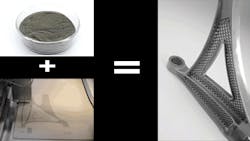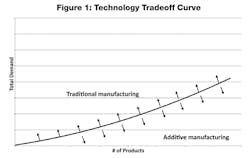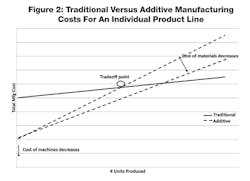Additive manufacturing (AM), also known as 3-D printing, is fundamentally different from traditional manufacturing. Instead of material removal or formation such as machining or injection molding, AM builds products from the bottom up, layer by layer. The process is highly flexible, with few constraints with regards to geometries or changeovers from one product to the next. From a cost perspective, we can view it as having low changeover costs but high variable unit costs due to the expense of the powdered materials used.
See Also: Supply Chain Technology & Automation Trends
Currently, there are two main roadblocks for the more widespread use of AM by industry: capabilities and costs. Capabilities refers to the range of usable finished goods that can be created. This is currently quite limited, due to the ability to create products with only one or two materials, the limited number of materials (e.g., powders) that can be used, and the inaccuracies and lack of reproducibility of the processes. However, all of this is being researched around the world, so I think we can expect these capabilities to rapidly improve over the next decade.
With regards to costs, there are two primary cost drivers: machines and materials. Machines can cost anywhere from a few thousand dollars up to a million dollars. As AM becomes more researched and widespread, we can expect the price to come down as the companies that create them achieve some economies of scale. More important for more industrial AM adoption, though, is the cost of materials.
See Also: 3-D Printing the Supply Chain
Materials are generally some powder-based polymer or metal that is fused, layer by layer, by some method such as a laser or adherent (it is worth noting that the materials do not have to be a powder, but that seems to be most common). These materials are currently relatively expensive and in some cases proprietary. But based on the underlying commodities upon which the materials are produced, there is significant room for the prices to drop.
The important point to understand, though, is the point of tradeoff. For instance, if I expect to sell 10,000 units, will it be cheaper and quicker to use AM? Referring back to the two cost drivers (machines and materials) with reference to Figure 2, a drop in machine costs will reduce the fixed costs (i.e., y-intercept) and push the tradeoff point further out in terms of units produced.
More importantly for AM adoption, though, is the cost of materials. As the materials get cheaper, the variable cost will reduce and the slope in the dashed line will decrease. This will really be the key to more widespread AM adoption, as the intersection of the two lines could potentially be pushed out further and further.
Alex Scott is a Ph.D. student in supply chain management at Penn State University. Prior to this he held several positions at IBM related to supply chain planning and execution. Scott is also a member of MH&L's Editorial Advisory Board.


